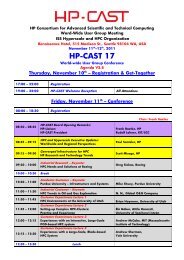ClusterPack Index of Tutorial Sections
ClusterPack Index of Tutorial Sections
ClusterPack Index of Tutorial Sections
Create successful ePaper yourself
Turn your PDF publications into a flip-book with our unique Google optimized e-Paper software.
<strong>of</strong> Gigabit Ethernet or Infiniband. The common components <strong>of</strong> a cluster are:<br />
� Head Node - provides user access to the cluster. In smaller clusters, the<br />
Head Node may also serve as a Management Server.<br />
� Management Server - server that provides single point <strong>of</strong> management for<br />
all system components in the cluster<br />
� Management LAN/switch - usually an Ethernet network used to monitor<br />
and control all the major system components. May also handle traffic to<br />
the file server.<br />
� Interconnect switch - provides high speed connectivity between Compute<br />
Nodes. Used for message passing and remote memory access capabilities<br />
for parallel applications.<br />
� Storage - includes both local disk space on each Compute Node and<br />
optionally an independent storage unit accessible to the Compute Nodes<br />
(See NAS below).<br />
� Cluster management s<strong>of</strong>tware - <strong>ClusterPack</strong> for system administrators<br />
and end-users.<br />
� Management Processor (MP) - controls the system console, reset and<br />
power management functions <strong>of</strong> a server.<br />
� Console LAN - network for remote management <strong>of</strong> consoles (ex. using<br />
the Management Processor LAN).<br />
� Network Attached Storage (NAS) - attach directly to Ethernet networks,<br />
providing easy installation, low maintenance, and high uptime.<br />
Compute Nodes<br />
Compute Nodes in a cluster are normal compute servers that provide system computing<br />
resource and storage capability. A <strong>ClusterPack</strong> cluster is built with HP Integrity servers: 2way<br />
or 4-way server platforms based on Intel Itanium 2-based processors and HP's zx1<br />
chipset technologies.<br />
The HP Integrity rx2600 server, powered by Intel Itanium 2-based processors, is the<br />
industry's first dual-processor Itanium 2-based server. The rx2600 dramatically improves<br />
price/performance for technical applications and gives customers a cost-effective yet<br />
powerful entry into a technology with tremendous growth potential. Its 2U rack density is<br />
ideal for clustering solutions.<br />
HP's extensive Itanium 2-based systems experience and co-developer insights have resulted<br />
in premium performance through the development <strong>of</strong> the HP Scalable Processor Chipset<br />
zx1. Invented by HP, the HP zx1 chipset fully unleashes the power <strong>of</strong> Intel Itanium 2-based<br />
processors by lowering memory latencies and increasing memory and I/O subsystem<br />
scalability. With the HP zx1 chipset, HP Integrity servers and Itanium 2-based servers<br />
achieve even better performance and memory expandability.<br />
Interconnection Networks<br />
An <strong>ClusterPack</strong> cluster is built with the industry standard Gigabit Ethernet. This<br />
interconnect network is capable <strong>of</strong> transferring data packets between Compute Nodes for<br />
both file serving and inter-node communication for applications. When applications benefit<br />
from lower latency, HP's Infiniband can be configured into the cluster to provide lower






